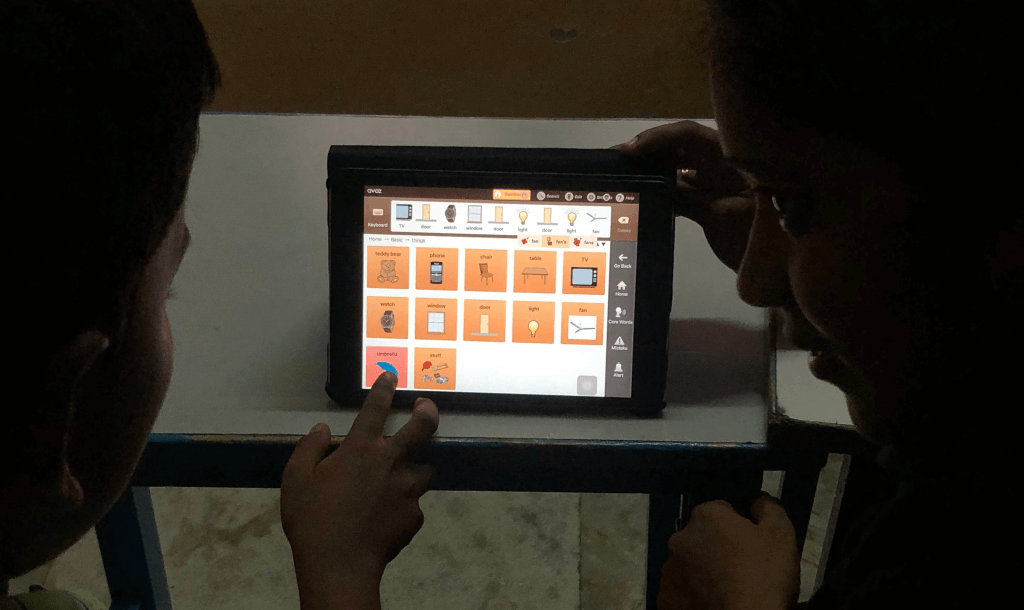

People with Autism can have difficulties with speech, language, and communication. Read on to learn how assistive technology for autism such as AAC can help in addressing some of the challenges faced by those with ASD.
AAC and Autism
Autism Spectrum Disorder (ASD) or Autism refers to a range of conditions including Asperger’s Syndrome and Pervasive Developmental Disorder Not Otherwise Specified (PDD-NOS). Social, behavioural, and communication challenges are common amongst those with ASD. The extent of these challenges can vary from person to person depending on the specific condition and the severity of symptoms.
While some people on the spectrum may have exceptional abilities and speak well, others may have limited speech and language abilities. A lack of speech, or deficit in language does not necessarily mean that the person has low intellect. So, it is important that people with ASD receive appropriate communication interventions such as AAC (Augmentative and Alternative Communication). Such interventions also give them the best possible chance at gaining literacy and social communication skills.
Why is Communication Intervention Important?
Communication is the bedrock of social interactions. So, for those with ASD, communication deficits can compound their troubles with making conversations in social situations. Communication also helps children with ASD connect to their parents, siblings, and teachers. It allows adults on the spectrum to foster significant relationships and participate actively in society.
According to experts, perceived problem behaviours in those with ASD may also be a way of communicating. When there is a lack of proper communication outlet, people with ASD may resort to disruptive behaviours to convey their irritability or disagreement. Providing them with an effective communication strategy such as AAC can help manage their emotions better. As is evident, enhancing communication skills enables people with ASD to deal with their other difficulties such as social and behavioural challenges.
Gives Them Control
There has been increasing autism awareness and acceptance over the years. But there is still a long way to go in terms of fully comprehending the disorder and its broad range of characteristics. With people on the spectrum, the emphasis sadly tends to be on controlling their atypical behaviours rather than giving them a sense of control.
Without communication interventions, non-verbal and minimally verbal children on the spectrum have no way to clearly express their opinions, preferences, misgivings, and grievances. Their ideas are taken for granted and choices are made for them. With AAC, they can learn to manipulate their surroundings and be an active participant in decision-making.
Promotes Self-Advocacy
Self-advocacy is essentially “speaking for yourself”. Parents must encourage self-advocacy in their children with autism because it can positively impact their self-esteem. It lets the child know that their ideas are valued and gives them the confidence to voice their opinions in social settings.
Since people on the spectrum can require the support of others, including parents, carers, and professionals, their independence can be undermined. So, parents must listen to the children and respect their right to disagree, refuse, or challenge their choices. The children should have easy access to icons in the AAC system through which they can say Yes or No, and express their approval or disapproval. Moreover, children must be encouraged to discuss, negotiate and present their ideas emphatically.
Self-advocacy also deters abuse and mistreatment of people with disabilities. Adults with ASD can use AAC to report their dissatisfaction with the care they receive. Consequently, it allows them to dictate the standard of support they get instead of settling for suboptimal care. Self-advocacy also helps reframe the public opinion of people with ASD and gives them the power to control the narrative.
Ways AAC Systems can Help Children with ASD
Providing symbol-based AAC to children with ASD can help them develop their vocabulary. This is because they respond better to visual information. AAC apps that allow symbol-based and text-based communication can help expand their language abilities when they are ready for it.
AAC systems can also help with a child’s comprehension of language. Since children with ASD can also have intellectual disabilities, they can take longer to process language and understand words. Besides, they may not be able to understand non-verbal communication.
Communication with AAC is typically slower than speech. Therefore, it gives the child more time to understand and respond to the information. The access to visual representation of the information allows them to construct appropriate responses at their own pace. This helps in stress-free communication for both them and their communication partners.
Several people with autism lead successful lives by learning to manage their symptoms. AAC is an important intervention strategy that ensures that they are not defined or limited by their communication deficits. Besides, early access to AAC gives them the tools to combat their challenges and lets them focus on their individual strengths and talents.
What are your thoughts on assistive technology for autism? Please share your ideas about AAC and autism in the comment section below.



